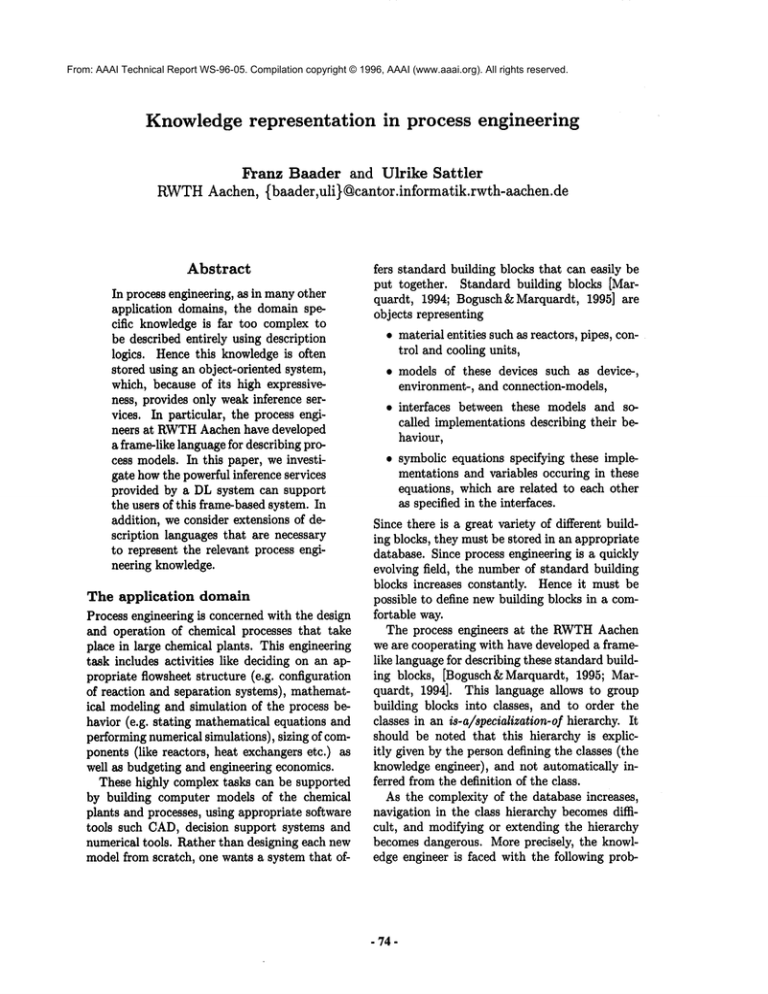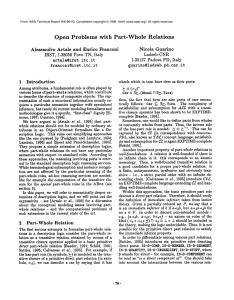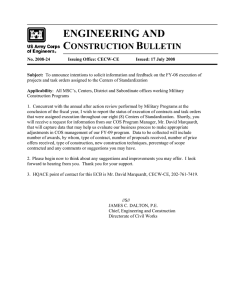
From: AAAI Technical Report WS-96-05. Compilation copyright © 1996, AAAI (www.aaai.org). All rights reserved.
Knowledge representation
in process
engineering
Franz Baader and Ulrike Sattler
RWTHAachen, (baader,uli}@cantor.informatik.rwth-aachen.de
Abstract
In process engineering, as in manyother
application domains, the domainspecific knowledgeis far too complexto
be described entirely using description
logics. Hencethis knowledgeis often
stored using an object-oriented system,
which, because of its high expressiveness, provides only weakinference services. In particular, the process engineers at RWTH
Aachen have developed
a frame-likelanguagefor describingprocess models. In this paper, weinvestigate howthe powerfulinference services
provided by a DL system can support
the users of this frame-basedsystem. In
addition, weconsider extensions of description languages that are necessary
to represent the relevant process engineering knowledge.
The application
domain
Process engineering is concernedwith the design
and operation of chemical processes that take
place in large chemicalplants. This engineering
task includes activities like deciding on an appropriate flowsheetstructure (e.g. configuration
of reaction and separation systems), mathematical modelingand simulation of the process behavior (e.g. stating mathematicalequations and
performingnumericalsimulations), sizing of components (like reactors, heat exchangersetc.)
well as budgeting and engineering economics.
These highly complextasks can be supported
by building computer models of the chemical
plants and processes, using appropriate software
tools such CAD,decision support systems and
numerical tools. Rather than designing each new
modelfrom scratch, one wants a system that of-
fers standard building blocks that can easily be
put together. Standard building blocks [Marquardt, 1994; Bogusch&Marquardt,1995] are
objects representing
¯ materialentities suchas reactors, pipes, control and cooling units,
¯ models of these devices such as device-,
environment-, and connection-models,
¯ interfaces between these models and socalled implementationsdescribing their behaviour,
¯ symbolic equations specifying these implementations and variables occuring in these
equations, whichare related to each other
as specifiedin the interfaces.
Since there is a great variety of different building blocks, they must be stored in an appropriate
database. Since process engineeringis a quickly
evolving field, the numberof standard building
blocks increases constantly. Henceit must be
possible to define newbuilding blocks in a comfortable way.
The process engineers at the RWTH
Aachen
weare cooperating with have developeda framelike languagefor describingthese standard building blocks, [Bogusch&Marquardt, 1995; Marquardt, 1994]. This language allows to group
building blocks into classes, and to order the
classes in an is-a/specialization-of hierarchy. It
should be noted that this hierarchy is explicitly given by the persondefining the classes (the
knowledgeengineer), and not automatically inferred fromthe definition of the class.
As the complexity of the database increases,
navigation in the class hierarchy becomesdifficult, and modifying or extending the hierarchy
becomesdangerous. Moreprecisely, the knowledge engineer is faced with the following prob-
- 74-
lems:
1. Finding an old class: If the knowledgeengineer does not know the exact name or even
definition of the class (s)he is looking for,
navigation in the class hierarchy is difficult,
especially in those parts of the database not
often used by the knowledgeengineer.
2. Defining a new class: There is no support
for finding the appropriate place in the hierarchy at which the new class should be inserted. This is left to the intuition of the
knowledge engineer.
Often, (s)he may know that A is a subclass
of B, but might be uncertain whether the
database already contains a more specific
subclass B~ of B such that A is also a subclass of B~. Because of this uncertainty it
often happens that the hierarchy becomes
broader than necessary.
On the other hand, the definition of the new
class might be inconsistent, have unintended
consequences, or may not be consistent with
the place in the hierarchy at which the new
class is inserted.
3. Distributed modeling: If the class hierarchy
is built by different persons simultaneously,
then there is a high probability that several
classes (with different names) describe the
same type of building block in syntactically
different terms. This does not only blow up
the size of the database; it is also a source
for misunderstanding and errors.
The rSle of the DL system
In order to avoid some of these problems, we intend to provide the database with an interface to
a description logic system. In principle, the DL
system maintains a TBoxthat contains concept
definitions that are obtained from the class definitions of the frame language. Since the frame
system does not have a strict formal semantics,
and since it provides means like methods, triggers, etc., which cannot be expressed in description logics, these concept definitions can only be
approximations of the class definitions. What we
require, however, is that the concept hierarchy
computed by the DL system coincides with the
class hierarchy of the frame system. This is accomplished by an interaction with the knowledge
engineer. Whenever (s)he defines a new class,
the corresponding concept is classified in the already existing concept hierarchy. If its place in
this taxonomydiffers from the place at which the
knowledgeengineer has put the class, then (s)he
is notified, and there are two different ways to
overcome the problem:
¯ either (s)he reconsiders her/his decision.
This happens if the knowledge engineer notices that the class definition was incorrect.
¯ or the concept is modified such that classification puts it at the right place. This happens if the class definition was correct, but
the corresponding concept does not reflect
the class definition entirely due to the restricted expressive power of the description
language.
Navigation can now be supported as follows: The
knowledgeengineer describes--possibly in an incomplete way--the class (s)he is looking for, and
then the description logic interface computesthe
most specific classes subsumedby this description. A closer look at these classes might then
reveal howto specialize the description, and the
process of going down in the hierarchy can be
continued until an appropriate concept is found.
The definition of new classes can be supported
since the subsumption test of the DLsystem can
compute all equivalent concepts, and then the
knowledge engineer can decide whether the newly
defined class is redundant or whether its definition must be modified. In addition, the concept
descriptions can be tested for unsatisfiability, and
the knowledge engineer can be warned whenever
unsatisfiability is detected.
The reason for using a DL system in
this context was, on the one hand, that
this type of knowledge representation
languages is rather similar to frame-like languages. On the other hand, DL systems are
equipped with subsumption algorithms necessary for providing the envisioned modeling support, as outlined above. In the last decade,
a great variety of different description logics has been investigated [Levesque & Brachman,
1987; Nebel, 1988; Schmidt-Schauss, 1989; PatelSchneider, 1989; Hollunder et al., 1990; Donini
et al., 1991; Baader&Hanschke, 1993; De
Giacomo&Lenzerini, 1994; Calvanese et al.,
1995]. However, the adequate representation of
standard building blocks for models in process
engineering requires additional expressive power.
Language extensions
The main concern is here to provide appropriate means for describing the structure of chem-
- 75-
ical plants, of the process models, of equations,
etc. For this reason, we have investigated partwhole relations (for the vertical representation of
structure), and more expressive number restrictions (which can be used to describe horizontal
relationships).
Part-whole relations:
Since the plants to be
modeled are very complex, one should be able
both to decompose and to aggregate devices and
connections occurring in the plants. A modeling
tool should thus be able to support top-down and
bottom-up modeling along a sufficiently
large
number of decomposition levels, or, even better,
along any (finite) number of decomposition levels.
In order to represent composite objects correctly, the inference algorithms of the DL system must take the special properties of partwhole relations into account. As in other applications [Gerstl& Pribbenow, 1993; Franconi, 1994;
Artale et al., 1994; Pribbenow, 1995], we were
thus confronted with the question
¯ which types of part-whole relations are
needed for the appropriate representation
of the complex objects in our application.
It turned out that objects are decomposed
with respect to the component-composite,
segment-entity, and member-collection relation, each of them a specialization of the general part-whole relation. Roughly speaking,
parts with respect to the member-collection
relation are not coupled with each other
and are of the same kind, whereas components are coupled with each other in a rather
arbitrary way and may be of quite different kinds; finally, segments are of a similar
kind, but coupled with each other. Since the
knowledge engineer might want to refer to a
part, not knowing on which level of decomposition it can be found and with respect to
which specific part-whole relation it is obtained, the general transitive part-whole relation must also be available.
¯ how these relations interact.
If, in the
intuition of the knowledge engineer, the
segment-entity relation is transitive, then it
must be represented as a transitive role. But
what about a component a of a segment b of
a whole c: is a also a componentof c? Questions concerning these interactions are not
yet completely answered, but without an ap-
propriate solution, composite objects cannot
be handled appropriately.
¯ which additional properties concerning the
part-whole relation are relevant in the application. For example, the existence of a
certain part can be essential for the proper
definition of the whole, in contrast to other
parts being optional; a part can be exclusive in the sense that it might be a part of
at most one object, without the possibility
to be shared by other objects; a part can be
functional for an object in that this object
does no longer work correctly if this part is
broken; and many other important properties are conceivable. The appropriate representation of these properties can be quite
useful: it allows, for example, to find out
whether all essential parts are specified; if
this is not the case, the knowledgeengineer
can be informed, and the missing parts can
be determined.
Since at least the general part-whole relation
is transitive, the DLsystem used in this application must be able to handle some kind of transitive relations. Hence, an interesting question is
in which ways transitive relations can be included
into description languages and howto design appropriate inference algorithms. In [Sattler, 1996],
three different extensions of the description language ¢4~ by transitivity have been investigated.
Number restrictions:
As in many other applications, objects in our application are often
characterized by the number of other objects to
which they are related via a certain relation. For
example, we want to describe devices having at
least 7 inputs or devices having exactly 5 outputs.
In description logics, this kind of knowledgecan
be expressed using numberrestrictions, as in
(device N (_~ 7 input)),
(device
Fl(---5 output)).
This traditional type of number restrictions
has rather weak expressive power: the roles occurring in them are atomic, and one can only
use fixed numbers(and not variables ranging over
numbers). To overcome this deficit, we have investigated various more expressive number restrictions.
In [Baader&Sattler, 1996a], we have introduced so-called symbolic number restrictions,
which allow for variables, and can thus be used
- 76-
to describe
concepts
likedevices
havingthesame
numberof inputsandoutputs,
as in
(devicen (= input) n (= output)),
Other interesting operators are intersection
and inversion of roles. Intersection can be used to
express, for example, that a devices has at least
2 bidirectional connections:
or devices having less inputs than each of their
parts have, as in
(devicen (= a input)n (Vprt.(> input))),
where a is interpreted as some nonnegative integer. The following example reveals a certain
ambiguity:
device [3 (> 2 input N output).
Inversion comes in if we need the role part-of
beside the role has-part. In [Baader & Sattler,
1996b], it is shown which types of complex roles
lead to undecidable inference problems, and for
which types of complex roles subsumption and
satisfiability remain decidable.
devicen (Vpart.(=
input)n (=output)))
Outlook
It describes devices where each part has the same
number of inputs and outputs. However, it depends on the reading whether different parts can
have different numbers of inputs or not. To overcomethis ambiguity, we introduced explicit existential quantification of numerical variables (denoted by $ a) to distinguish between (1) a device
where for each of its parts the numberof its inputs equals the number of its outputs and (2)
device where all parts have the same number of
inputs and outputs:
device
(Vpart.($
o~.(=inp ut) [7 (= O(OUtpUt))) (1)
devicer]
(¢ .(Vpart.(=
a input)
n (=output)))
Unfortunately, it turned out that the basic inference problems, such as satisfiability
and subsumption, are undecidable if this kind of number
restrictions is allowed in an unrestricted way. For
a restricted language, we have shownthat satisfiability is decidable.
Another interesting extension is to allow for
complex roles in number restrictions.
For example, we are interested in describing devices that
have at most 7 parts that are componentsof their
components, as in
This paper describes work in progress. From
our cooperation with process engineers, we have
learned that the system services provided by DL
systems appear to be very useful for their application: a description logics based browser could
support the engineers in building and maintaining their frame-based database. Before building
this browser, we have investigated which expressive power is needed to describe relevant properties of objects occuring in this application. It
turned out that transitivity and expressive number restrictions play an important r61e in this
application.
However, we have not yet made a
final decision as to which particular description
logic is "most appropriate". Weneed to find a
compromise between necessary expressive power
and acceptable computational complexity. In the
near future, such a description language will be
fixed and we will test whether the support DL
systems can provide in this application is really
as high as we expect.
References
[Artale et al., 1994] A. Artale, F. Cesarini,
E. Grazzini, F. Pippolini, and G. Soda. Modelling composition in a terminological language
environment. In Workshop Notes of the ECAI
devicen(_<7 has-componentohas-component), Workshop on Parts and Wholes: Conceptual
Part-Whole Relations and Formal Mereology,
pages
93-101, Amsterdam, 1994.
or we want to describe a device that is controlled
by the same control unit as all the devices it is
[Baader & Hanschke, 1993]
connected to:
F. Baader and P. Hanschke. Extensions of
concept languages for a mechanical engineerdeviceN
In Proe. of the 16th Ger(= 1 control-by
U connect-toocontrol-by). ing application.
man AI-Conference,
GWAI-92, volume 671
In these examples, complex roles are built using
of LNCS, pages 132-143, Bonn, Deutschland,
the operators composition and union of roles.
1993. Springer-Verlag.
- 77 -
[Baader & Sattler, 1996a]F. Baader and U. Sattler. Description logics with symbolic number
restrictions.
In W. Wahlster, editor, Proc. of
ECAI-96. John Wiley & Sons Ltd, 1996.
[Baader & Sattler, 1996b] F. Baader and U. Sattler. Numberrestrictions on complex roles in
description logics. In Proc. ofKR-96. M. Kaufmann, Los Altos, 1996. To appear.
[Bogusch & Marquardt, 1995] R. Bogusch and
W. Marquardt. A formal representation of process model equations. Computers and Chemical Engineering, 19:211-216, 1995.
[Calvanese et al., 1995] D. Calvanese,
acomo, and M. Lenzerini. Structured
Modeling and reasoning. In Proc.
95, volume 1013 of LNCS, pages
1995.
G. De Giobjects:
of DOOD229-246,
[Patel-Schneider, 1989] P. F. Patel-Schneider.
Undecidability of subsumption in NIKL. AIJ,
39:263-272, 1989.
[Pribbenow, 1995] S. Pribbenow.
Modeling
physical objects: Reasoning about (different
kinds of) parts. In Time, Space, and Movement Workshop 95, Bonas, France, 1995.
[Sattler, 1996] U. Sattler. The complexity of concept languages with different kinds of transitive roles. In G. GSrz and S. HSlldobler, editors, 20. Deutsche Jahrestagungflit Kiinstliche
Intelligenz,
volume 1137 of LNALSpringerVerlag, 1996.
[Schmidt-Schauss, 1989] M. Schmidt-Schauss.
Subsumption in KL-ONEis undecidable. In
Proc. of KR-S9, pages 421-431, Boston (USA),
1989.
[De Giacomo & Lenzerini, 1994] G. De Giacomo
and M. Lenzerini.
Concept language with
numberrestrictions and fixpoints, and its relationship with mu-calculus. In Proc. of ECAI94, 1994.
[Donini et al., 1991] F. Donini, M. Lenzerini,
D. Nardi, and W. Nutt. The complexity of
concept languages. In Proc. of KR-91, Boston
(USA), 1991.
[Franconi, 1994] E. Franconi. A treatment of
plurals and plural quantifications based on a
theory of collections.
Minds and Machines,
3(4):453-474, November1994.
Gerstl
[Gerstl &Pribbenow, 1993] P.
and S. Pribbenow. Midwinters, end games and
bodyparts. In N. Guarino and R. Poli, editors,
International Workshop on Formal Ontology93, pages 251-260, 1993.
[Hollunder et al., 1990] B. Hollunder, W. Nutt,
and M. Schmidt-Schauss. Subsumption algorithms for concept description languages. In
ECAI-90, Pitman Publishing, London, 1990.
[Levesque & Brachman, 1987] H. Levesque and
R. J. Brachman. Expressiveness and tractability in knowledgerepresentation and reasoning.
Computational Intelligence, 3:78-93, 1987.
[Marquardt, 1994] W. Marquardt. Trends in
computer-aided process modeling. In Proc. of
ICPSE’94, pages 1-24, Kyongju, Korea, 1994.
[Nebel, 1988] B. Nebel. Computational complexity of terminological reasoning in BACK.Artificial Intelligence, 34(3):371-383, 1988.
- 78-






